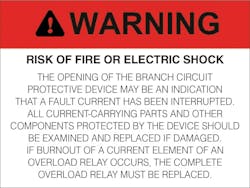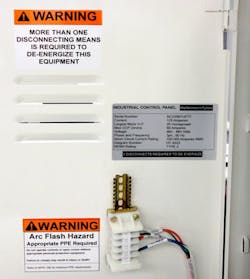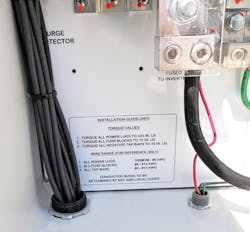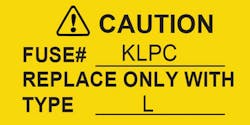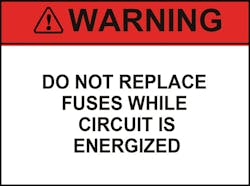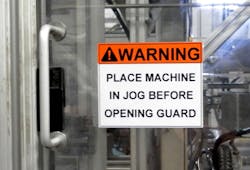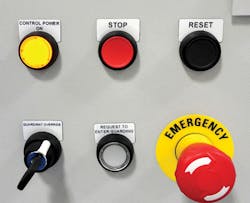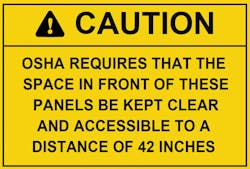In part one of this two-part series on code-compliant electrical equipment labeling, we recognized that OSHA is moving toward more citations, greater penalties, and more frequent inspections. We also noted how labeling has become a critical component of ensuring worker safety and reducing client liability. After starting our discussion at the service entrance of the building and moving through equipment like motor control centers, feeders, switchboards, and panels, it’s time to turn our attention to industrial control panels and industrial automation equipment.
Industrial control panels
Industrial control panels require much of the same labeling as described for the switchboards and panelboards. However, some additional requirements are worth noting. Article 409 of the NEC provides the designer/installer and enforcement authorities with the minimum requirements to facilitate the safe installation and inspection of industrial control panels. It became effective Jan. 1, 2005. Until that time, industrial control panels had been installed based upon general electrical requirements from several different areas in the NEC. Part of the changes were driven by the fact that as more companies used industrial control panels, there was a significant increase in the misapplication of control products and related equipment.
Article 409 also impacts the way equipment is designed and constructed so the entire panel — and all components inside — meet a defined short circuit current rating (SCCR) for the application and is marked with the appropriate SCCR. If the control manufacturer is a UL 508A shop, it’s certified by UL to apply a serialized label that reads “UL 508A” with a unique serial number supplied by UL. Usually, the shop pays an annual fee to UL to maintain the listing. When a UL inspector arrives, he or she will expect to see the associated SCCR label applied in conjunction with the UL508A label. Note: The SCCR label is also required, even if the shop is non-UL-approved.
If there are several items within the panel, such as circuit breakers, a motor control unit, and a starter, the lowest rated SCCR of the device within the control panel must be used as the controlling factor for marking the panel. If the overall SCCR is a high-fault rating, an additional label needs to be applied with the language shown in Fig. 1.
Industrial control panels supplied by more than one power source shall be marked to indicate that more than one disconnecting means is required to de-energize the equipment, per NEC 409.110(1), (2) and (3) [Photo 1]. This rule states where multiple disconnecting means are used and parts of the controllers remain energized from a source other than the one disconnected, a warning sign shall be clearly legible and visible that reads: “Warning – Parts of the Controller are not De-Energized by this Switch.”
The benefit of using an SCCR is that it helps eliminate hazards where components and equipment could be applied above their ratings. It also makes the inspection and approval process much easier for engineers and inspectors, and contributes to a safe electrical system by guarding against arc flash hazards.
Although typically customer-specified, all wiring, conductors, and additional critical components should be labeled. One might rationalize this based on NEC 480.4(A) in which all circuits should be identified. However, it’s important to realize that this type of labeling is usually industry standard and meant to help facilitate future repair work and/or expansion of the panel. Section 13.1.1.3 of the 2012 edition of NFPA 79, “Electrical Standard for Industrial Machinery,” indicates that “terminals for more than one conductor shall be so identified.”
If your industrial control panel is installed at the point of entry for the electrical supply circuit, the panel must be marked “Service Entrance Equipment” per the International Electrotechnical Commission (IEC) “EN Standard EN60 204-1(2)” and NEC Art. 409. Remember Sec. 13.1.1.6 of NFPA 79 also states, “terminals on terminal blocks shall be plainly identified to correspond to markings on the diagram.”
For some applications (e.g., grounding, fuse plugs, tap bars, and terminal blocks), the manufacturer might specify a specific torque value. NEC 110.3(A) covers the examination, inspection, and installation of equipment. Many manufacturers will place a “torque” label next to or adjacent to the equipment (Photo 2) to make it easier for the inspector or whoever is doing service to maintain the integrity of the system.
The same can apply to fuses. To maintain the proper SCCR rating, any fuses that must be replaced have to be the same type and rating as the original fuse. In this case, a simple label (Fig. 2) that identifies the replacement fuse is critical to maintaining the system.
Breakers and disconnects
For overcurrent devices, NEC 225.70(3) states that suitable warning signs shall be erected in an obvious place adjacent to fuses, warning operators not to replace fuses while the circuit is energized. As we can see in Fig. 3, if you have a medium-voltage substation in a facility, then you would place this label on anything 600V or higher. Anything under 600V has the fuses contained in some type of disconnecting means, which will automatically turn off power if the user attempts to access the fuses. Appropriate labeling as shown is critical, but many times easily ignored or simply not enforced.
Industrial automation
Finally, industrial automation equipment must have appropriate and legible warnings, notices, and instructions for the operator. Section 2.1 of the 2011 edition of ANSI Z535.4, “American National Standard for Product Safety Signs and Labels,” outlines the performance requirements for designing and implementing safety signs and labels, which are used to identify hazards for persons using, operating, servicing, or in proximity to, a wide variety of equipment. A new category called “Safety Instructions” was added in the 2011 edition of this standard.
Per Sec. 205.10 of NFPA 70E, 2012 Edition, identification of components (where required) and safety-related instructions (operating or maintenance), if posted, shall be securely attached and maintained in legible condition. Up-to-date operating and safety instructions and necessary warnings are vital to ensure employee safety for industrial automation.
Labeling in this area is tied more toward OSHA and ANSI Z535 requirements and can include: button labels for machine operations; danger, caution, and warning signs; and informational notices that are designed to help the operator understand and avoid hazards. When examining Sec. 16.3 of NFPA 79, notice it states, “control devices, visual indicators, and displays used in the operator machine interface shall be clearly and durably marked with regard to their function either on or adjacent to the unit.” In addition, Sec. 16.5.4 of this same standard states, “all control panel devices shall be plainly identified with the same designations as shown on the machine drawings or diagrams” (Photo 3 and Photo 4). Even the emergency stop label defined in Sec. 10.7.3 is required to be yellow (Photo 5).
Industrial automation labels can vary widely in verbiage and application. Warning, danger, and caution signs indicate different levels of potentially hazardous situations. The “signal” word needs to be at least 50% larger than the body text. The “safety alert” symbol is used in conjunction with the signal word (Photo 6). Typically, the word “caution” is displayed in black letters on a yellow background (Fig. 4), the word “warning” is black letters on an orange background, and the word “danger” is white letters on a red background.
Per ANSI Z535.4-2011, Sec. 6.3: a safety alert symbol, when used with the signal word, shall precede the signal word.
Per ANSI Z535.4-2011, Sec. 6.4: A contrasting border “may” be used to achieve distinctiveness.
Per ANSIZ535.4-2011, Sec. 7.4: The safety symbol should normally have a black symbol on a white background. Other colors can be used for safety symbol emphasis, such as safety red for fire, etc.
Note: It is possible to print two-color labels per ANSI Z535.4 – 2011, Sec. 7.6.2, which allows the color of the signal word panel to be the same for the message panel as long as the color ink contrasts with the color of the background.
Per ANSIZ535.4-2011, Sec. 8.1.1: Signal words shall be in sans serif letters in upper case only.
OSHA 1910.145(e)(2) states: “The wording of any sign should be easily read and concise. The sign should contain sufficient information and be easily understood. The wording should make a positive, rather than negative, suggestion and should be accurate in fact.”
Finally, even if warning signs are in place, make sure they are not worn out, faded, damaged, or in a condition that makes them difficult to read — this is another way to get an OSHA citation. Per NFPA 70E, Sec. 205.11: Warning signs, where required, shall be visible, securely attached, and maintained in a legible condition.
Wrap-up
The labeling of equipment in a facility is not only critical, but also tied directly to NEC, OSHA, ANSI, and NFPA regulations and standards. With the advent of modern labeling systems, there’s little excuse for not being able to generate all of the labels shown in this article on-demand or in-house, even when a custom design is needed.
Senator Patty Murray (D-Wash.) reintroduced Senate Bill 1166 in 2011. It expanded OSHA coverage, increased, civil and criminal penalties, and addressed various reporting requirements. The end result is that companies should expect heavier enforcement and larger fines in the future. So, the best defense is a good offense. In other words, be prepared for an inspection by implementing proper labeling procedures before it is too late.
Fries is a technical consultant with HellermannTyton, North America, in Milwaukee. He can be reached at [email protected].

